NCC
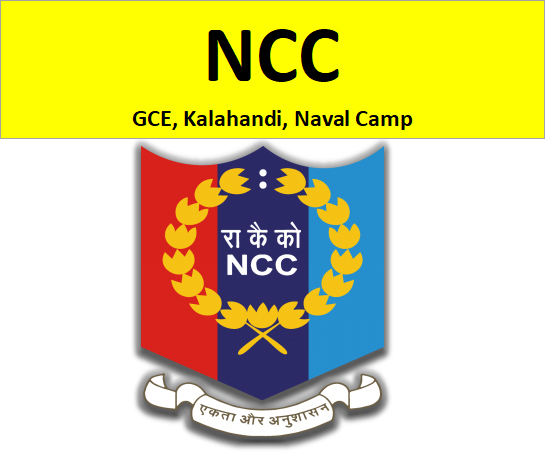
Post held: Care Taking Officer (CTO)

GCEK Naval Unit
Dilip Kumar Bagal
Assistant Professor-II
Department of Mechanical Engineering
GCE, Kalahandi
Full Form of “NCC”
NCC stands for “National Cadet Corps”
- The National Cadet Corps (NCC) is a youth development movement in India that aims to instill discipline, patriotism, and a sense of adventure among young citizens.
N - National
- The term "National" signifies that the organization operates at a national level, encompassing the entire country of India.
C - Cadet
- A cadet is a young person, typically between the ages of 12 and 26, who is undergoing training in a military or quasi-military organization.
C - Corps
- The term "Corps" refers to a large, organized group of people who work together towards a common goal.
About “NCC”
- National Cadet Corps (NCC) is a national-level organization that aims to develop the CHARACTER and PERSONALITY of young citizens through various training programs and activities, with a focus on discipline, patriotism, and adventures.
- The NCC organization is administered through the Ministry of Defense (MoD).
- The National Cadet Corps (NCC) is the youth wing of the Indian Armed Forces with its headquarters in New Delhi, India.
- It is open to school and college students on voluntary basis as a Tri-Services Organisation, comprising the Army, the Navy and the Air Force.
History and Origins of “NCC”
- The roots of the NCC trace back to the “University Corps,” established under the Indian Defence Act of 1917. Its primary purpose was to address the shortage of personnel in the Indian Army.
- In 1920, the “University Corps” evolved into the “University Training Corps” (UTC), aiming to attract more youth and contribute to the “Indianization” of the armed forces.
- During World War II, the UTC didn’t meet expectations, leading to the idea of creating a better scheme for training young men even during peacetime.
- Finally, in 1948, under the leadership of India’s first Prime Minister, Pandit Jawaharlal Nehru, the NCC was officially established.
- The last Sunday of November is celebrated as “NCC Day” in honor of this occasion.
Objectives and Activities of “NCC”
Cadets in the NCC receive basic military training, including small arms handling and drill. The NCC emphasizes values such as unity and discipline.
Activities included in “NCC”
Drill and Parade: Learning military drills and marching.
Adventure Training: Rock climbing, trekking, and other outdoor pursuits.
Social Service: Engaging in community development projects, blood donation drives, and environmental initiatives.
Republic Day Parade: Selected cadets participate in the Republic Day parade in New Delhi.
Size and Reach in “NCC”
The NCC is massive, with approximately 10 to 13 lakh (1-1.3 million) cadets across the country.
It operates through various directorates at the state and regional levels.
Motto and Values in “NCC”
The NCC is massive, with approximately 10 to 13 lakh (1-1.3 million) cadets across the country.
The NCC’s motto is “Unity and Discipline” (एकता और अनुशासन).
These values are instilled in cadets, emphasizing teamwork, cooperation, and adherence to rules.
The NCC encourages LEADERSHIP development, social SERVICE, and a sense of RESPONSIBILITY toward the nation.
History of “Motto in NCC”
The purpose of having a motto for NCC India was studied on 11th August 1978 in the 11th Central Advisory Committee meeting. The members of the Committee suggested the following mottos –
- Duty and Unity
- Duty and Discipline
- Unity and Discipline (adopted on 23 Dec 1957)
- Duty, Unity and Discipline
Among all these recommendations, they selected “Unity and Discipline” in the next CAC meeting of 12th October 1980.
Flag of “NCC”
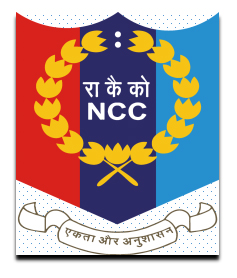
In 1954 the existing tri-colour flag was introduced.
The three colours in the flag depict the three Services of the Corps, RED for the Army, DEEP BLUE for the Navy and LIGHT BLUE for the Air Force.
The letters NCC and the NCC crest in gold in the middle of the flag encircled by a wreath of lotus, give the flag a colorful look and a distinct identity.
Each lotus represents one NCC Directorate.
Ranks and Insignia of the “NCC”
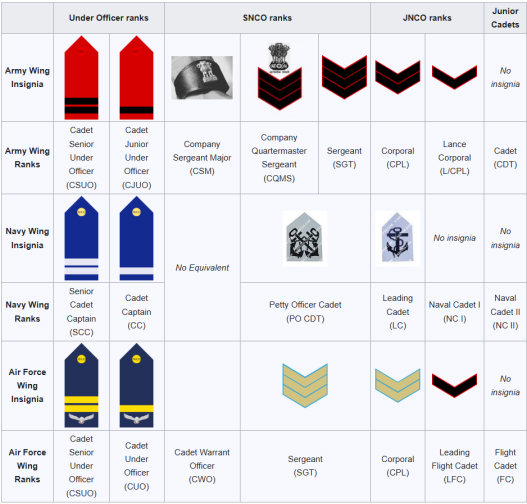
Certificates & Examination in “NCC”
There are Three Certificates in NCC
Certificate – A : It can be taken by JD/JW cadets of the NCC, during class year 8 and 9 and 10.
Certificate – B : It can be taken by SD/SW cadets of the NCC, after class year 10 and those studying for a degree.
Certificate – C : Is the highest level certificate for NCC cadets. It can be taken in the third year of training, in the third year of degree course.
Various Camps in “NCC”
- Republic Day Camp (RDC)
- Combined Annual Training Camps (CATC)
- National Integration Camp (NIC)
- Advance Leadership Camp (ALC)
- Army Attachment Camp
- Hiking And Trekking Camps
- Thal Sainik Camp (TSC)
- Vayu Sainik Camp (VSC)
- Nau Sainik Camp (NSC)
- All India Yachting Regetta (AIYR)
- Rock Climbing Training Camps (RCTC)
- Naval Wing Activities
- Air Wing Activities
- Youth Exchange Programme (YEP)
- Overseas Deployment
Present DG NCC
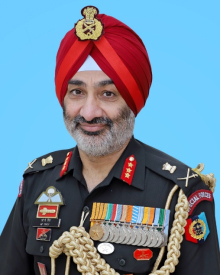
Lieutenant General Gurbirpal Singh, AVSM, VSM, Lieutenant General Gurbirpal Singh, AVSM, VSM was commissioned into The PARACHUTE REGIMENT in 1987. An alumnus of the National Defence Academy, Khadakvasla and the Indian Military Academy, Dehradun.
Government Website of “NCC”
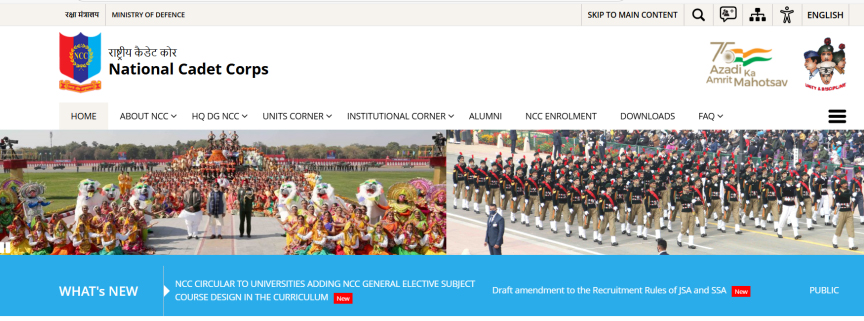
Organisational Structure of “NCC”
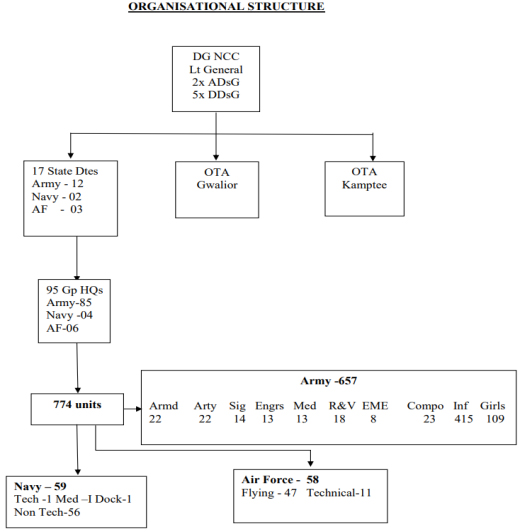
Song of “NCC”

Your turn to “NCC”
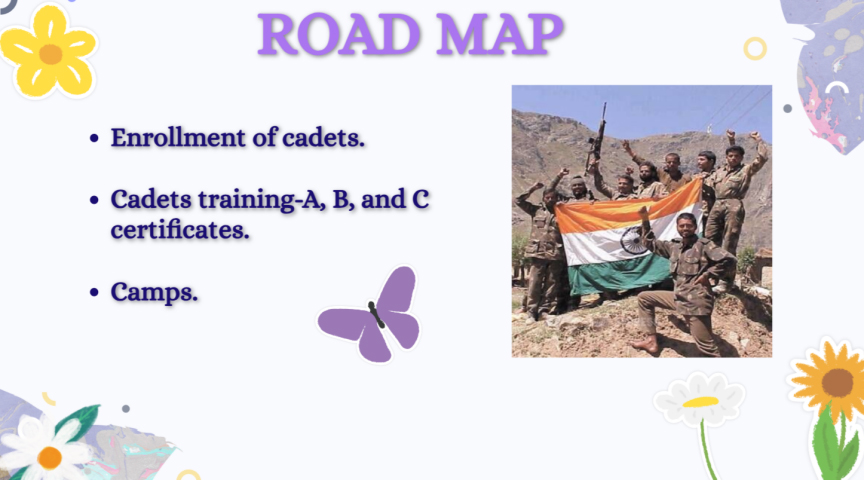
Student Activities
